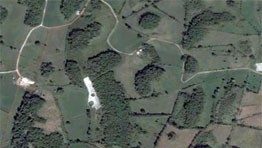Conservation Corridor Digest Describes Connectivity Research at Climate Science Centers

The following post was written for Conservation Corridor, a website supported by the SE CSC that provides information about the science of landscape corridors as it relates to applied conservation strategies, by Holly Padgett of NCCWSC.
Climate Science Centers are key for connectivity research in the U.S.
 Habitat fragmentation and loss threaten the well-being and survival of many wildlife communities. Climate change is projected to exacerbate these problems by further disrupting landscapes. To make matters worse, climate change is also expected to shift the range of many species, forcing them to expand into new areas to find more suitable temperatures and adequate food supplies – a challenge made difficult, if not impossible, by disconnected landscapes.
Habitat fragmentation and loss threaten the well-being and survival of many wildlife communities. Climate change is projected to exacerbate these problems by further disrupting landscapes. To make matters worse, climate change is also expected to shift the range of many species, forcing them to expand into new areas to find more suitable temperatures and adequate food supplies – a challenge made difficult, if not impossible, by disconnected landscapes.
Land and wildlife managers in every country are faced with reducing risks like habitat fragmentation to wildlife, ecosystems, and landscapes, simultaneously reducing risks to activities such as hunting and recreation. Maintaining connectivity between habitats is a key strategy for conserving populations into the future, and for ensuring that bth individual species and ecosystems can adapt to changing environments. Sound scientific information is undeniably needed to inform these conservation actions.
In the U.S., the regional Department of the Interior Climate Science Centers (CSCs) address this need. There are eight regional CSCs that cover all states and territories, and they are managed by the National Climate Change and Wildlife Science Center within the U.S. Geological Survey (USGS). They provide unbiased scientific information to land, wildlife and natural resource managers and planners across the country.
For example, scientists with the Southeast CSC recently assessed current and projected connectivity for three species that inhabit bottomland hardwood forests, a habitat of high conservation concern. Not surprisingly, the study suggests that under anticipated climate conditions, there will be fewer connections for species to move between suitable habitats. Moreover, the team made several recommendations to managers, including that they focus on multiple species for a more holistic representation of connectivity across a landscape, rather than using an “umbrella species” approach.
In another study, scientists funded by the Northwest CSC scientists partnered with land and wildlife managers from Washington and British Columbia to assess connectivity challenges for 13 priority species and ecosystems and to identify a diverse set of possible adaptation responses. These responses include implementing prescribed burns, controlling invasive species, or restoring riparian areas to maintain existing core habitats and connections.
Currently, scientists funded by the North Central CSC are working in partnership with state and federal natural resource managers and private land trusts to examine connectivity and conservation strategies in the Northern Rockies. This project includes a component to explore how well existing management plans and conservation efforts are expected to support crucial connections for wildlife in the future.
Through these and many other projects, the CSCs aim to conduct science that directly informs adaptation and conservation decisions.
Read the post on Conservation Corridor